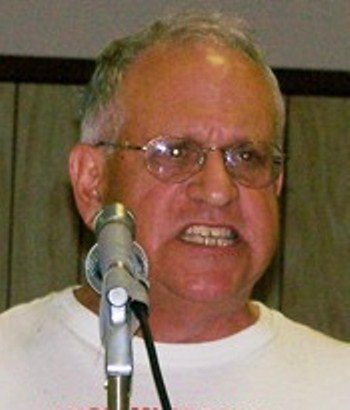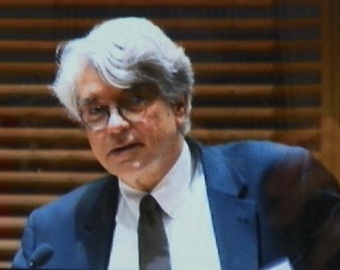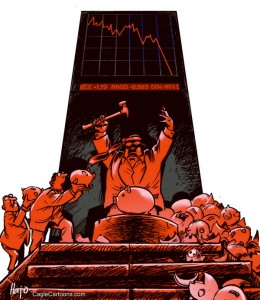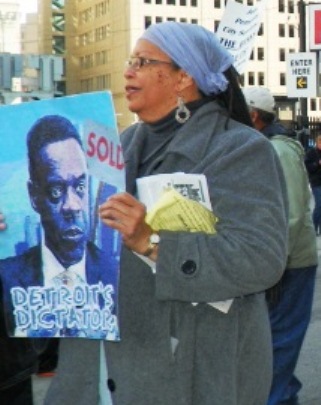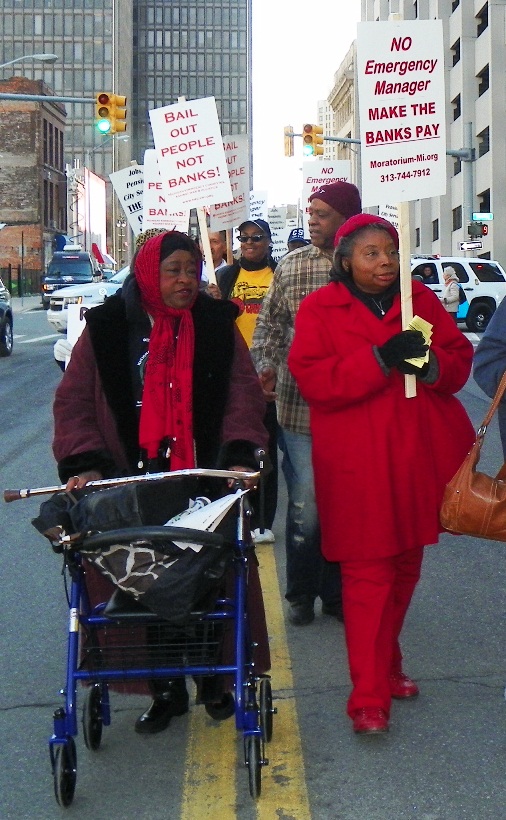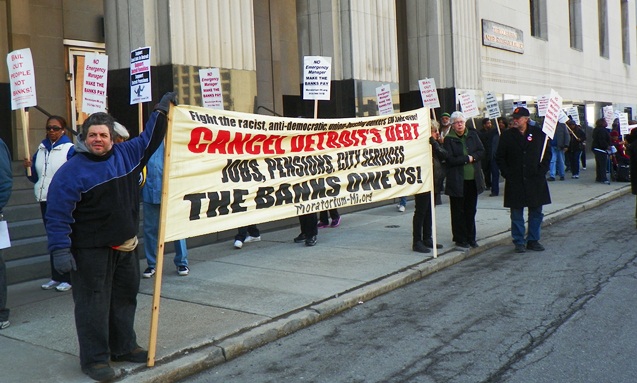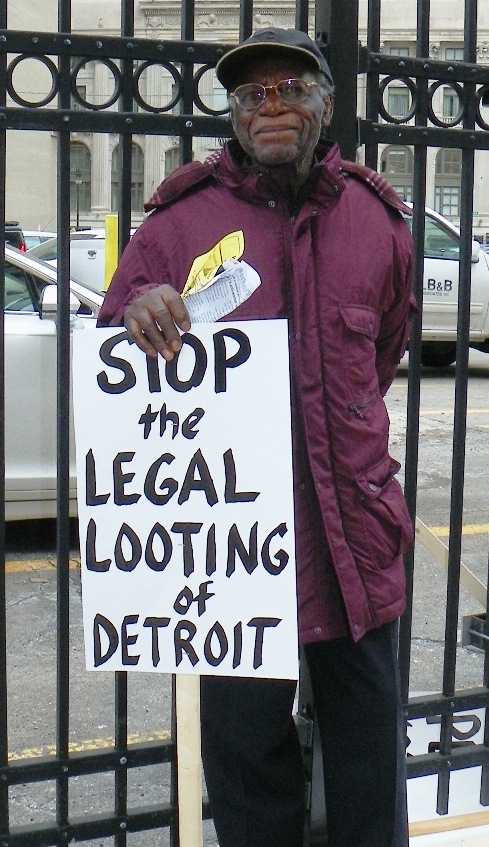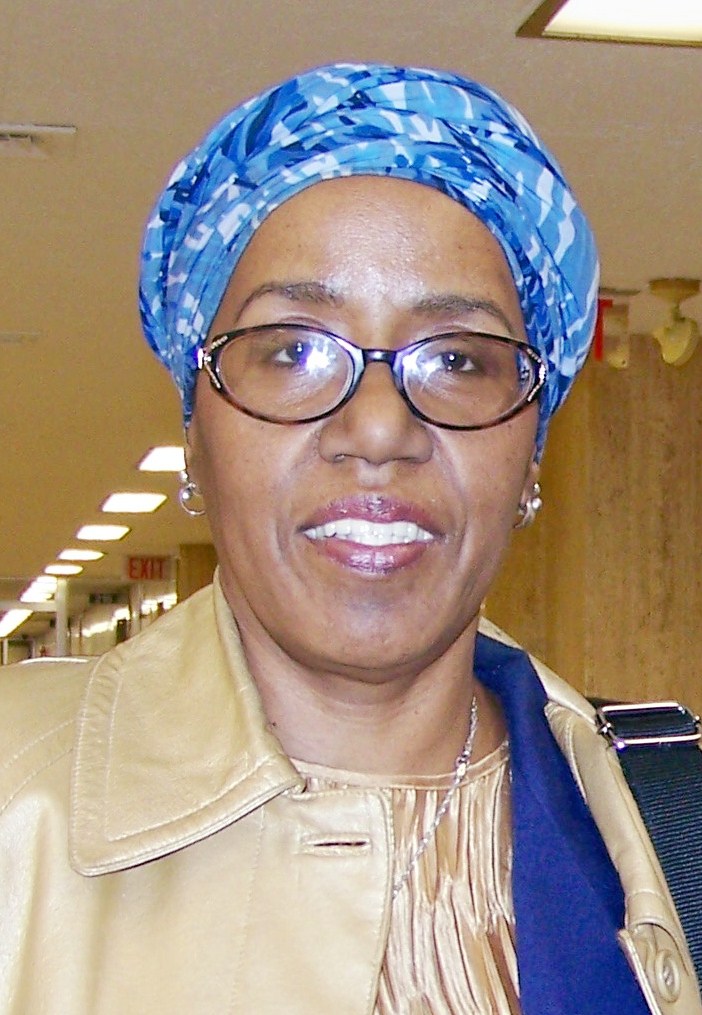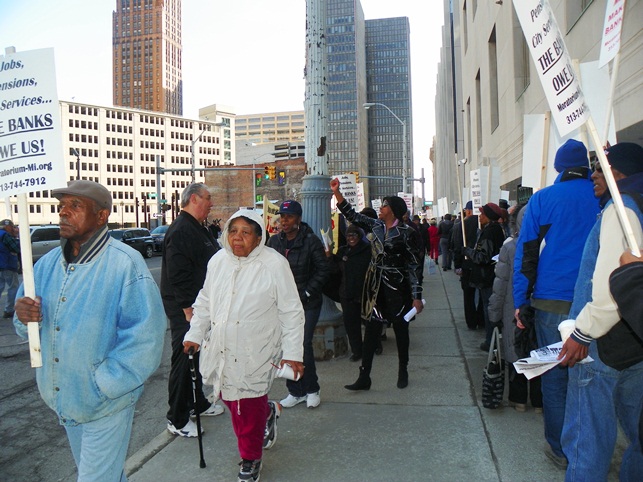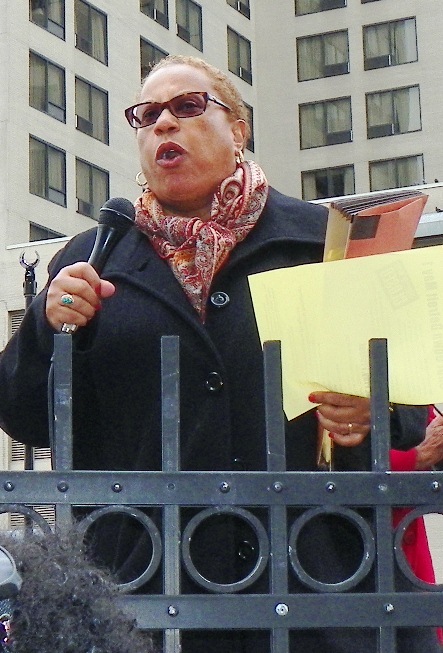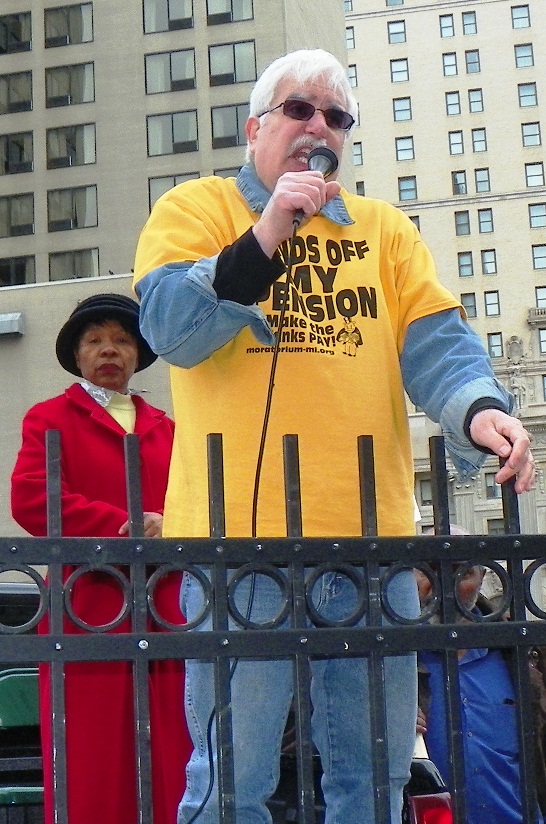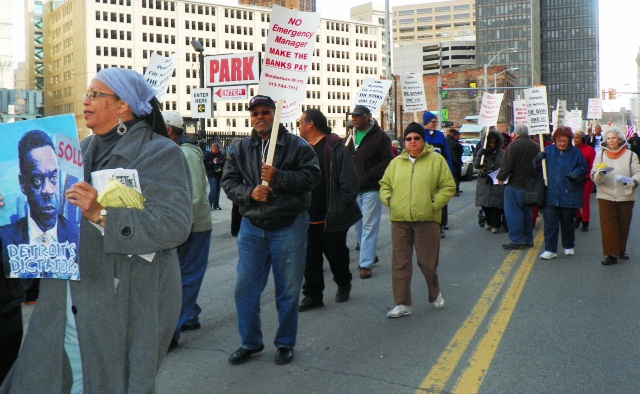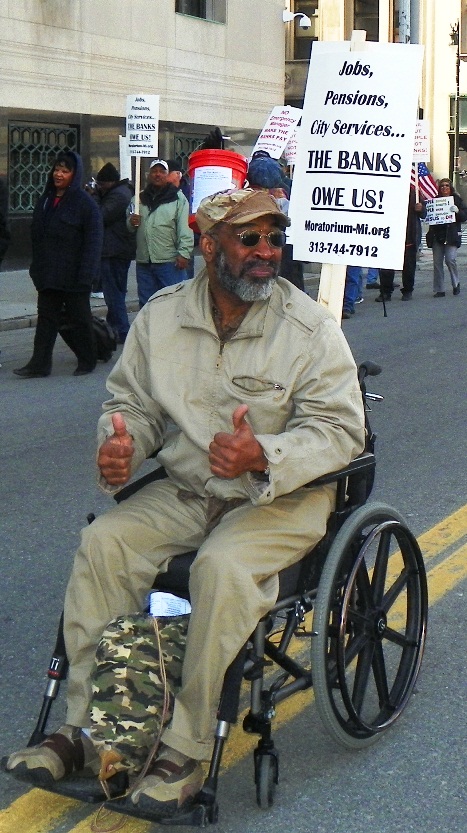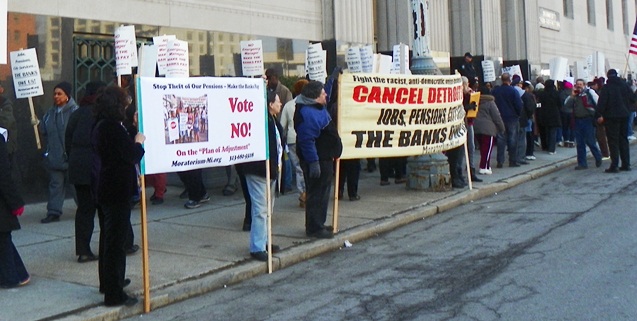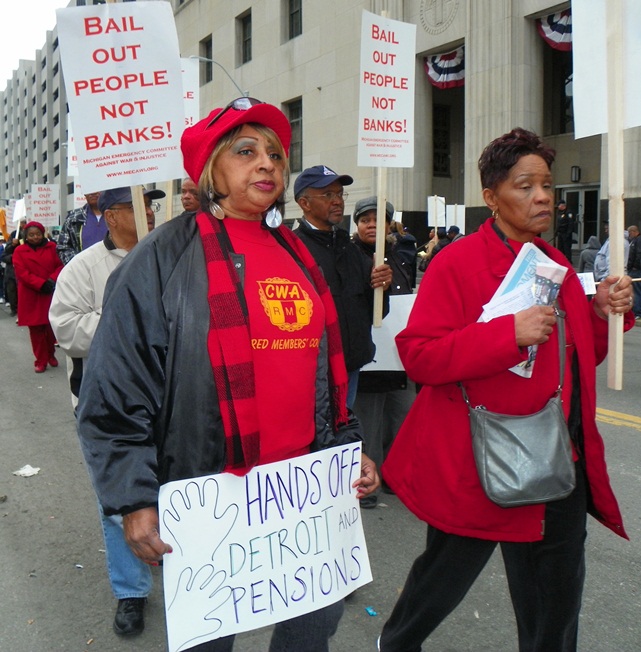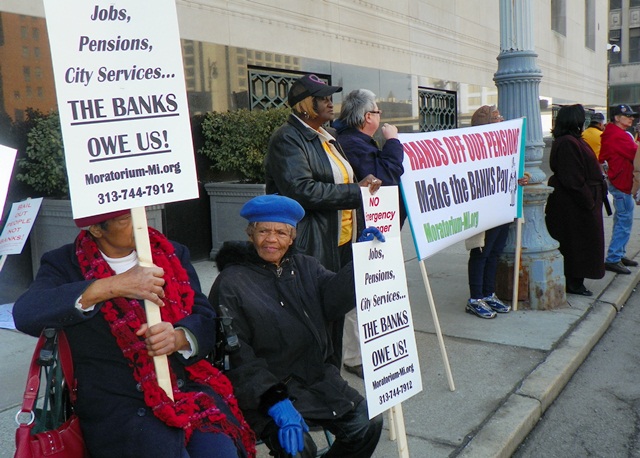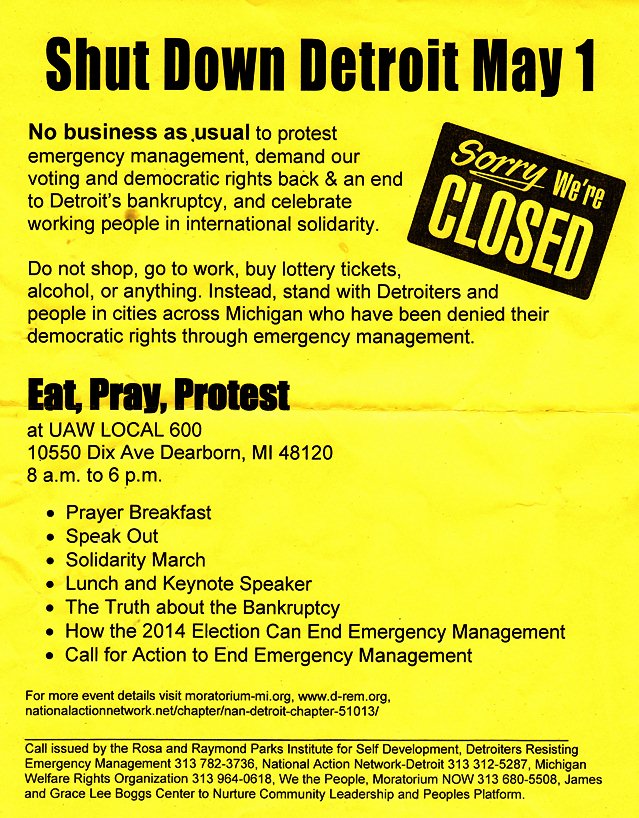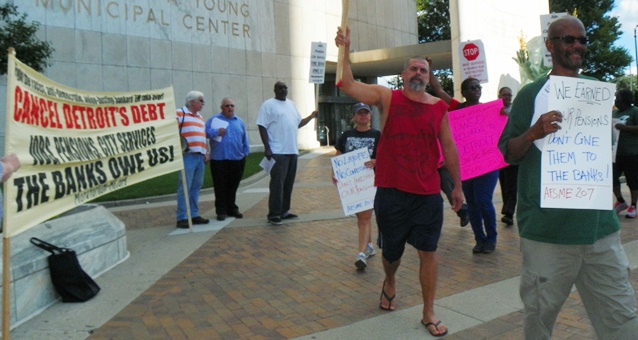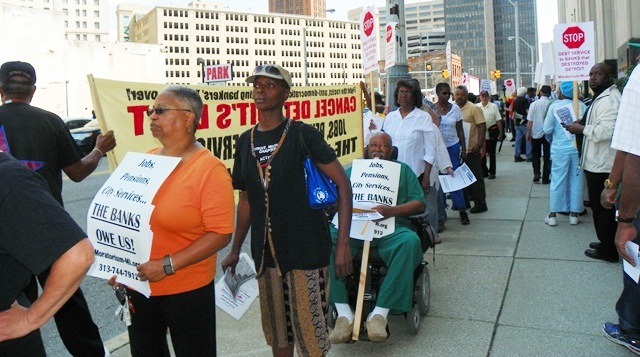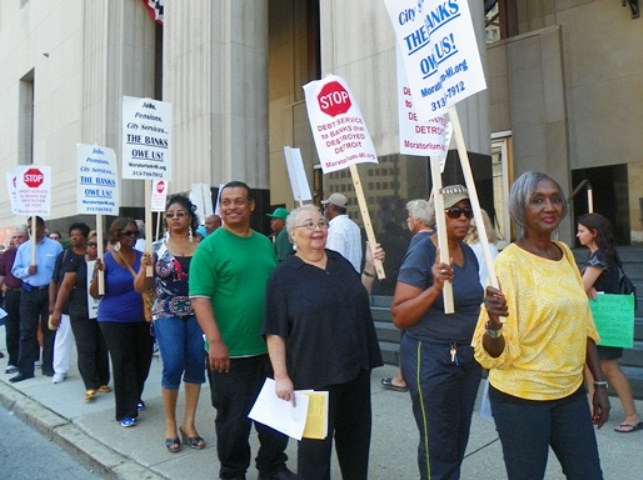VOD NEEDS DONATIONS NOW–LINKS IN STORIES
VOD WELCOMES NEW SUBMISSIONS!
If you want to be published on VOD, please submit your articles, etc. to diane_bukowski@hotmail.com. Call 313-825-6126 to alert us.-
Recent Posts
- DEATH OF IMAM JAMIL AL-AMIN/H.RAP BROWN REIGNITES DEMANDS FOR JUSTICE, RECOGNITION OF HIS HEROIC LIFE
- SENTINEL REPORT: KYM WORTHY, CIU’s, DPD, SADO LEAVE MASSES OF WRONGLY CONVICTED TO ROT AND DIE IN MDOC
- FREE WRONGLY CONVICTED LIFER DAVID MCKINNEY, CHARGE INKSTER COPS ANTHONY DELGRECO, OTHERS
- LET OUR BROTHERS GO! RICKY RIMMER, GREGORY ALLEN, DESHON STOKES! SAT. OCT. 11 @12 NOON MLK JR. HIGH
- WRONGLY CONVICTED, MICHEAL ‘MIKE D’ DEGRAFFINRIED FREED AFTER 26 YRS; NEW TRIAL HEARINGS OCT. 9, NOV. 11
- COUNCIL CANDIDATE JAMES HARRIS’ S.T.R.E.S.S. COP, DRUG DEALER DAD BUSTED BY FEDS; SPENT 20 YRS. IN PRISON
- WOMEN AT HURON VALLEY PRISON WIN FED. COURT RULING BLASTING HORRIFIC CONDITIONS, DENYING MDOC IMMUNITY
- FREE RICKY RIMMER! DETROIT MAYORAL CANDIDATE ATTY. TODD PERKINS MEETS WITH RR’S SUPPORTERS JUNE 8
- DONATE TO VOD BEFORE JUNETEENTH! KEEP STORIES OF CONVICTIONS BY CROOKED COPS, PROSECUTORS ON-LINE
- CEDRIC TOOKS HOME AFTER 47 YRS, RESENTENCED AS 18-YR. OLD JUVENILE, LEADS WAY FOR HUNDREDS MORE
- MICH. SUPREME COURT ORDERS RESENTENCINGS FOR LIFERS AGED 18, 19, 20, AFFECTING AT LEAST 830 IN MDOC
- WE REMEMBER AFENI SHAKUR JAN. 10, 1947 – MAY 2, 2016; “BLACK PANTHER PARTY HISTORY IS WOMEN’S HISTORY”
- PROF. PENNY GODBOLDO, DR. MARGARET BETTS SPONSOR “MEDITATION MOVEMENT & MEDICINE” SAT. MAR. 29 10A-2P
- MICH. SUPREME COURT TO RULE RE: LIFERS CONVICTED UNDER 21, OTHERS CHARGED WITH FELONY MURDER
- DUGGAN’S DECADES-LONG DETROIT DEMOLITION DERBY
- ATTEND FRIENDS OF RETURNING CITIZENS (F.O.R.C.) SUPPORT GROUP MEETINGS TUESDAYS 6 – 7:30 PM
- EXONEREE THELONIOUS SEARCY PACKS COURT; JUDGE DELAYS RE-TRIAL, DENIES TETHER REMOVAL PER NESSEL
- FREE DOUBLE R IN 2025! DETROIT PROTESTS FOR RICKY RIMMER FORCED ACTION, CASE GOING TO APPEALS COURT
- CHARGES DISMISSED VS. DEMETRIS ‘MEECH’ KNUCKLES EL, COUSIN JAN. 16, 2025; TONS OF SUPPORTERS SHOWED
- FIGHT THE POWER! JOIN THELONIOUS ‘SHAWN’ SEARCY IN COURT FRI. JAN. 10 VS. ‘INNOCENCE DENIER’ KYM WORTHY
- DONATE TO VOD IN 2025! HELP EXPOSE CRIMES OF COPS, PROSECUTORS, JUDGES WHO FRAMED 1,000’S IN MDOC
- GAYELON SPENCER, JR. FIGHTS MURDER 2 CONVICTION: COPS DESTROYED EVIDENCE, BIASED MEDIA COVERAGE
- WILLIE MERRIWEATHER MEMORIAL SAT. DECEMBER 14, 4PM: HERO WHO GAVE HIS LIFE TO SAVE OTHERS FROM PRISON
- DIRTY DETROIT COPS BEAT, MADE UP CONFESSIONS FROM ALTON HUBBARD, BROTHER IDOLTHUS, IN 2004 MURDERS
- ROGER CARLOS RAY WINS EVIDENTIARY HEARING ON 3RD TRY; EXONEREE LAVONE HILL CALLS FOR RAY’S RELEASE
Monthly Archives
Links
- Al Jazeera news
- All of Us Or None, prisoners and former prisoners
- All-African People's Revolutionary Party
- American Tribune, the prison experience
- Black Agenda Report
- Black is Back Coalition
- Black List
- Block Report Radio
- Color Lines
- DBA Press
- Defend Freedom of the Press
- Detroit Parents with Special Ed Students
- Free Mumia Abu Jamal
- Free Mumia Abu Jamal news
- Gray Zone
- Hood Research
- Jamahiriya News Agency–Free Libya
- Kenny Snodgrass: You Tube
- Labor Notes
- Libya 360
- Mac Speaking: Leona McElvene YouTube site
- Maryanne Godboldo
- MI Emergency Ctte. v War & Injustice
- Michigan Welfare Rights Organization
- Monthly Review Online
- Nadir's Detroit music scene
- Photography is Not a Crime
- Press TV world news
- Prison Legal News
- Project B.A.I.T.
- Real News Network
- Russia Today
- San Francisco Bay View newspaper
- SCG News: World News, Politics and Analysis
- THE GRAYZONE
- We the People of Detroit
- Wikileaks
DETROIT BASED INTERNET TV SUBSCRIPTION SERVICE LAUNCHES CROWD FUNDING CAMPAIGN
March 29, 2014
DETROIT — UIN, a Detroit-based Internet TV subscription service and online movie distributor, is launching a crowd funding campaign through Indiegogo. UIN is the parent company of Detroit IPTV. Not all high tech companies are based in the Silicon Valley.
 As you may know, 2013 was the first time there was a drop in subscribers of the combined cable and dish networks. In essence 2012 was the peak year for cable subscribers. Many of those viewers are finding their way to the Internet. The reason for the migration is that the Internet offers so much more for so much less.
As you may know, 2013 was the first time there was a drop in subscribers of the combined cable and dish networks. In essence 2012 was the peak year for cable subscribers. Many of those viewers are finding their way to the Internet. The reason for the migration is that the Internet offers so much more for so much less.
UIN has been compared to Netflix and Hulu. What makes UIN different is the fact that UIN offers locally produced shows that highlight local issues.
Funds from this campaign will be used to buy equipment to update the websites and promote the business. With the potential merger of giant cable companies, the UIN network will offer a platform for local communities to have a voice and promote their interest.
To make a contribution from $1 to $1,000 or more, click this link: https://www.indiegogo.com/project/preview/f9a11cf5
ABOUT UIN
UIN LLC is an Internet TV Subscription Service. There are affiliates in several major cities. The movie distribution arm features a platform for Independent movie producers to market the product outside of Film festivals. For more information, go to:
313 574 8075
Posted in Uncategorized
Leave a comment
VIETNAM IS SENTENCING CORRUPT BANKERS TO DEATH, BY FIRING SQUAD

Duong Chi Dung (C-front), 56, former chairman of Vinalines, and his accomplices listen to the verdict at a local People’s Court in Hanoi on December 16, 2013. Two top executives were sentenced to death for embezzlement as authorities try to allay rising public anger over corruption. Three corrupt bankers have also recently the death sentence. (Staff/AFP/Getty Images)
Others just get life behind bars.
April 3, 2014 00:33 Global Post
 BANGKOK — For the most part, American bankers whose rash pursuit of profit brought on the 2008 global financial collapse didn’t get indicted. They got bonuses.
BANGKOK — For the most part, American bankers whose rash pursuit of profit brought on the 2008 global financial collapse didn’t get indicted. They got bonuses.
Odds are that scandal would have played out differently in Vietnam, another nation struggling with misbehaving bankers.
The authoritarian Southeast Asian state doesn’t just send unscrupulous financiers to jail. Sometimes, it sends them to death row.
Amid a sweeping cleanup of its financial sector, Vietnam has sentenced three bankers to death in the past six months.
One duo now on death row embezzled roughly $25 million from the state-owned Vietnam Agribank. Their co-conspirators caught decade-plus prison sentences.
In March, a 57-year-old former regional boss from Vietnam Development Bank, another government-run bank, was sentenced to death over a $93-million swindling job.
 According to Vietnam’s Tuoi Tre news outlet, several of his colluders were sentenced to life imprisonment after they confessed to securing bogus loans with a diamond ring and a BMW coupe. And last week, in an unrelated case, charges against senior employees from the same bank allege $47 million in losses from dubious loans.
According to Vietnam’s Tuoi Tre news outlet, several of his colluders were sentenced to life imprisonment after they confessed to securing bogus loans with a diamond ring and a BMW coupe. And last week, in an unrelated case, charges against senior employees from the same bank allege $47 million in losses from dubious loans.
None of this would impress Bernie Madoff, mastermind of America’s largest ever financial fraud scheme. The combined amount from all three Vietnamese cases adds up to less than 1 percent of his purported $18-billion haul.
But these death sentences nevertheless are high profile scandals in Vietnam.
That’s the point. Human rights watchdogs contend that splashy trials in Vietnam are acts of political theater with predetermined conclusions. The audience: a Vietnamese public weary of state corruption. But these sentences also sound loud alarm bells to dodgy bankers who are currently running scams.
“It’s a message to those in this game to be less greedy and that business as usual is getting out of hand,” said Adam McCarty, chief economist with the Hanoi-based consulting firm Mekong Economics.
“The message to people in the system is this: Your chances of getting caught are increasing,” McCarty said. “Don’t just rely on big people above you. Because some of these [perpetrators] would’ve had big people above them. And it didn’t help them.”
Like most nations that crush dissent and operate with little transparency, Vietnam is highly corrupt.
According to a World Bank study, half of all businesses operating within the communist state expect that gift giving toward officials is required “to get things done.” Transparency International, which publishes the world’s leading corruption gauge, contends Vietnam is more corrupt than Mexico but not quite as bad as Russia.
Unlike in America, where judges can’t sentence white-collar criminals to death, Vietnam can execute its citizens for a range of corporate crimes.
Amnesty International reports that death sentences in Vietnam have been handed down to criminals for running shady investment schemes, counterfeiting cash and even defaulting on loans. This is unusual: United Nations officials have condemned death for “economic crimes” yet Vietnam persists with these sentences — as does neighboring China.

Part of the UN Declaration of Human Rights, which global corporations and banks are continually violated. The U.S. did not sign on to this agreement, or the UN Declaration on the Rights of the Child.
Though statistics on Vietnam’s opaque justice system are scarce, a state official conceded that more than 675 people sit on death row for a range of crimes, according to the Associated Press.
It’s still unclear how the bankers will be killed. Vietnam’s traditional means of execution involves binding perpetrators to a wooden post, stuffing their mouths with lemons and calling in a firing squad. The nation wants to transition to lethal injections. But European nations refuse to export chemicals used in executions (namely sodium thiopental) to governments practicing capital punishment.
Fraudulent bankers are receiving heavy sentences at a moment when Vietnam is enacting major financial reforms.
For decades, Vietnam has been slowly transforming its communist-style, state-run market into a more open and competitive arena. In the post-reunification era, the government owned every bank in Vietnam. Today, state-run banks control only 40 percent of all assets.
 This push to bank in a more Western style has ushered in improvements as well as temptations to swindle. According to the UN economist Vu Quang Viet, Vietnamese credit laws passed in 2010 “simply copied the lax US law now widely believed to be at least partially responsible for the financial debacle in 2008.”
This push to bank in a more Western style has ushered in improvements as well as temptations to swindle. According to the UN economist Vu Quang Viet, Vietnamese credit laws passed in 2010 “simply copied the lax US law now widely believed to be at least partially responsible for the financial debacle in 2008.”
Campaigns to root out corruption are promoted as a way to entice foreign investment, which could help prop up Vietnamese banks whose growth has slowed from a sprint to a jog.
But the recent death sentences aren’t really intended to prove the reformers’ sincerity to the outside world, according to McCarty.
“They don’t care about foreigners. It’s all internal politics,” McCarty said. Foreign banking honchos wouldn’t be impressed by a few executions anyway. “If you really want to want to resolve the problem, you can’t just arrest people,” he said. “You’ve got to improve accountability and transparency in the entire system.”
A leading Vietnamese newspaper, Thanh Nien, is also pushing for system-wide cleanup in lieu of showcase trials against a few corporate criminals.
An op-ed in the paper recently compared death sentences for corruption to fighting fire with fire. The preferred approach would be dousing corruption before it burns through public funds. “It is better to prevent corruption,” the paper opined, “than deal with it after the fact.”
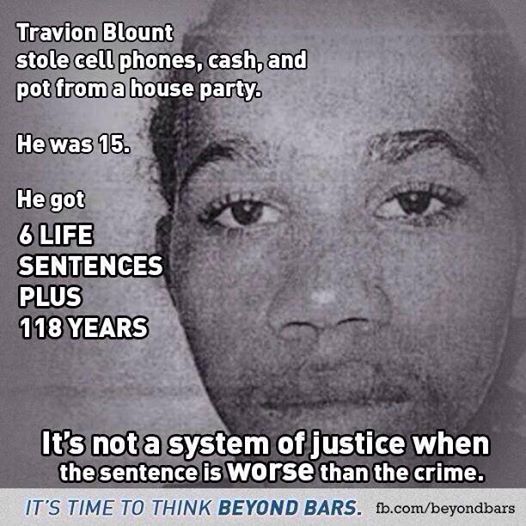 VOD commentary: Vietnam and other previously socialist-led countries across the world have been thoroughly undermined by the United States through economic manipulation and military intervention. But clearly some of their peoples’ original sentiments remain and have forced the above measures. During the Chinese revolution in its then predominantly agricultural economy, landlords faced firing squads; now Vietnam is subjecting banksters to the same fate.
VOD commentary: Vietnam and other previously socialist-led countries across the world have been thoroughly undermined by the United States through economic manipulation and military intervention. But clearly some of their peoples’ original sentiments remain and have forced the above measures. During the Chinese revolution in its then predominantly agricultural economy, landlords faced firing squads; now Vietnam is subjecting banksters to the same fate.
The World Bank, quoted in the article above, has been responsible for the suffering and deaths of millions across the world through its demands for debt payments instead of human services. (See video above.) Economic crimes of the magnitude committed in the U.S. by global banksters, including millions of illegal foreclosures based on predatory lending and the decimation of municipal economies have most certainly led to the actual deaths of many through homelessness, stress and hunger.
Instead of focusing on these mass murderers, the U.S. prefers to send 2.5 million mostly poor people to prison, many for life, and many at ages as young as 14 and 15. It accounts for 25 percent of the incarcerated population in the world, but only 5 percent of the total global population.
Related article: http://voiceofdetroit.net/2014/04/09/detroit-bankruptcy-swaps-agreement-huge-cramdown-cuts-for-retirees-residents-billions-for-banks/
Posted in Uncategorized
Leave a comment
DETROIT BANKRUPTCY ‘SWAPS’ AGREEMENT: HUGE ‘CRAMDOWN’ CUTS FOR RETIREES, RESIDENTS; BILLIONS FOR BANKS

(L to R) BOA CEO BRIAN MOYNIHAN, DETROIT EM KEVYN ORR, MICH. GOV. RICK SNYDER, UBS CEO SERGIO ERMATTI
U.S. Bankruptcy Judge Steven Rhodes to rule Fri. April 11 on total $385 million “swaps” proposal
“Settlement Agreement” bars cancellation of $1.45 BILLION in outstanding, illegal city COPS debt to UBS AG, BOA
Banks would approve EM Orr’s Plan of Adjustment, including huge cuts to workers and retirees pensions, annuities, health care
Orr speeds to final judgment Oct. 15 while Sixth Circuit and U.S. District Courts dally on appeals
By Diane Bukowski
April 9, 2014
DETROIT – U.S. Bankruptcy Court Judge Steven Rhodes is to rule April 11 on a “Settlement Agreement” between the City of Detroit (EM Kevyn Orr as imposed by the state) and UBS AG and Bank of America (Merrill Lynch). The city proposes to pay $85 million to the banks to write off interest “swap” agreements related to a $1.5 billion “Pension Obligation Certificate” (POC) loan from the two banks.
The amount is down from $230 million and $165 million in earlier agreements rejected by Judge Rhodes, the last on Jan. 16. It is being touted as a bargain for the city by the major media, which cites the alleged swaps debt as $288 million.
But Attorney Jerome Goldberg told Judge Rhodes during a hearing April 3, “It was very clearly the court’s holding on Jan. 16 that the city is reasonably likely to succeed in invalidating the swap agreements [in litigation], and would have the potential to recover the $300 million already paid to the swap counterparties. What the banks are receiving is actually $385 million including what they have already taken. That’s more like a 67 percent payout on a total of $588 million, not 30 percent as EM Orr testified.”
Noting proposed retiree cuts including pensions, annuities, COLA and health care amount to 50-60 percent, he said, “The City has the potential to recover money from the banks, not pay them. Equity plays a role in this courtroom, and when you combine the legal claim with equities I don’t see any way that this court can OK this settlement any more than others. Since this settlement, the SEC launched a lawsuit in February Feb. against UBS and BOA for LIBOR fraud. A leader of BOA’s municipal securities division was jailed in February. This is symptomatic of the problem with the swaps and part of the overall crisis brought on by banks through their fraudulent practices.”
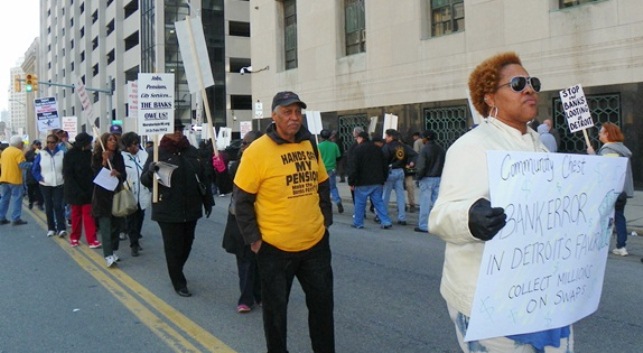
Marcher demands city collect millions on swaps during April 1, 2014 protest outside bankruptcy court.
The agreement also essentially bars further claims on the two banks to cancel the $1.45 BILLION still outstanding in POC principal and interest. In a Jan. 31 filing, Orr asked Rhodes to cancel that debt, saying it was “void ab initio, illegal and unenforceable” because it constituted an end run around the city’s debt limits under state law among other factors.
“UBS and Merrill Lynch (BOA) did the swaps, and were the managers of the COPS deal, all stuck together,” Prof. Wallace Turbeville explained during a forum at Wayne State University April 8. “They told the city they have a right to grab 20 percent of city revenues and keep them until all of the termination rate gets paid. The city agreed quickly to settle, three days before filing bankruptcy, for 80 cents on the dollar. The bankruptcy judge said no, that’s too high. The EM burst out of the courtroom and renegotiated. The good thing was he had to work during Christmas, but the court said the new amount was still too high. In this third time, the payment of $85 million includes a release for UBS and Merrill Lynch from any liability associated with the [overall] COPS deals.”
Turbeville authored the Nov. 13 Demos report on Detroit’s bankruptcy, which denied the city should be in bankruptcy at all and challenged the legality of the COPS deals.
For the first time in this third agreement, UBS AG and BOA pledge to approve Orr’s “Plan of Adjustment” (POA), including cuts to workers and retirees, likely water privatization with increased rates, and other measures that will hurt city residents. Objectors say judicial approval of the settlement agreement would make it immune from challenge during the POA trial.
The parties make it expressly clear that a chief purpose of the settlement is to facilitate a “cramdown” by Judge Rhodes of the POA if the majority of creditors do not approve it.
“ . . .the Swap Counterparties have similarly agreed to support and vote in favor of a plan that is consistent with the compromise, which will facilitate the City’s ability to confirm a plan of adjustment, including, if necessary, a cramdown plan of adjustment over the objection of a dissenting class or classes,” says Section 51 of the 79-page agreement. (See link below for entire agreement.)
During his appearance in bankruptcy court March 3, Orr said the city’s attorneys from Jones Day and Pepper Hamilton had drafted a lawsuit in the event that UBS AG and BOA did not agree to drop their payment demands below $100 million.
“There was a complaint, a motion for an injunction, a brief that accompanied the injunction, a new city ordinance, an EM order to effectuate, orders revoking letters of instruction to casinos, and my affidavit,” Orr testified on direct exam. “There were 17 counts in the complaint, including void ab initio, unjust enrichment, superior knowledge, fraud [et al.]”
Orr alleged litigation would be too time-consuming and costly, despite the fact that most of the documents were already drawn up.
Orr said the $85 million agreement in lieu of $288 million claimed by the banks was in line with cuts of 70 to 80 percent proposed for other city creditors, in particular the pension funds.
“The parties agree to use their best efforts not to attempt to sue, to make sure casino revenue is not trapped,” he said. In other words, the swaps are still out there and casino revenue is still at stake, despite state law which bars its use for anything other than “Quality of Life” city services, as Judge Rhodes noted in his Jan. 16 ruling.
Meanwhile, as Orr, Jones Day, and the rest of their highly paid consultants rush to judgment day, matters on pending lawsuits challenging Rhodes’ bankruptcy eligibility ruling and the constitutionality of Public Act 436, the “Emergency Manager Act,” are proceeding at more of a snail’s pace.
The Sixth Circuit Court of Appeals agreed to bypass U.S. District Court and hear eligibility appeals from seven creditor groups representing city retiree and union members on Feb. 21, 2014, but not on an expedited basis as requested by the appellants.
At the same time, the Sixth Circuit sent a letter to the appellants indicating it would be in touch with U.S. District Court Chief Judge Gerald Rosen, a right-wing Federalist Society member, who is acting as mediator in the bankruptcy case, to assess the progress of mediation without disclosing specifics.
The appellants on March 7 asked that their filings be forwarded directly to the panel members in the case. A Sixth Circuit Court Clerk told VOD that the court does not disclose the identity of panel members until actual hearings are scheduled.
The panel selection is key because the Sixth Circuit’s Chief Judge Alice Batchelder, an appointee of President Reagan’s, designated Judge Rhodes to hear the Detroit bankruptcy case in accordance with protocol.
As VOD revealed in earlier stories, Judge Rhodes chaired a forum on Chapter 9 and Emergency Managers Oct. 10, 2012. Five of the six speakers advocated both. One was a co-author of PA 436’s predecessor PA 4, two trained emergency managers, and another, Charles Moore of Conway McKenzie, has been a chief witness for Orr/Jones Day in the bankruptcy trial.
In U.S. District Court, a lawsuit originally filed by Catherine Phillips of Michigan AFSCME Council 25 et. al. against Gov. Rick Snyder and other state officials which challenges the constitutionality of PA 436 is finally being heard before U.S. District Court Judge George Caram Steeh, a Clinton appointee. In order to get Judge Rhodes to lift the stay protecting state officials from lawsuits, the City of Detroit was removed as a plaintiff and the lawsuit now covers only cities in the rest of the state.
Detroit is the only major city facing bankruptcy that is not under elected rule. Under Chapter 9 provisions, creditors cannot demand liquidation of a municipality’s assets “unless the debtor agrees.” The unelected Orr has already said he plans to privatize Detroit’s Water and Sewerage Department if a regional authority is not established. Negotiations on that matter are ongoing as part of the bankruptcy proceedings, frequently held at the New York City offices of Jones Day instead of in Detroit where water workers and rate payers cannot be present.
A hearing before Steeh on the state’s motion to dismiss the PA 436 case is scheduled for April 30, 2014.
On a positive note, the Sixth Circuit Court of Appeals upheld an injunction preventing health care cuts to City of Flint retirees on Jan. 3. The Court earlier made a similar ruling regarding City of Pontiac retirees.
Related documents:
DB Settlement agreement ppf 3 3 14
DB Sole objection to 3rd swaps 3 17 2014
DB OCR objection to 3rd swap 3 17 14
DB AFSCME obj to 3rd Swap 3 17 14
Related articles:
http://www.mlive.com/news/flint/index.ssf/2014/01/health_care_cuts_halted_again.html
http://voiceofdetroit.net/2014/04/02/thousands-of-retirees-residents-march-at-detroit-bankruptcy-court-send-out-call-to-shut-city-down-may-1/
http://voiceofdetroit.net/2014/03/28/detroit-declares-war-on-pensioners-proposed-cuts-amount-to-70/
Posted in Uncategorized
Leave a comment
DETROIT PARKING WAR ON THE POOR! ORR JACKS UP FINES, ENDS 10-DAY GRACE; PUBLIC HEARING MON. APR. 14, 3 P.M.
 Detroiters, rise up—this is the last straw!
Detroiters, rise up—this is the last straw!
Parking rate hikes come on top of water/sewerage hikes and shut-offs, parked car impoundments for no insurance, police Gestapo raids in poor communities for minor violations
By Diane Bukowski
April 7, 2014
Detroit – Detroit PA 436 dictator Kevyn Orr today announced he will hold a public hearing on drastically increasing parking fines and late fees, as well as eliminating half-payment if the fine is paid in ten days.
The public hearing is to take place Monday, April 14, at 3 P.M. in the Coleman A. Young Municipal Center, at Woodward and Jefferson, in the Erma Henderson Auditorium on the 13th floor.
Thirty dollar fines are to be increased to $45, as are parking meter violations and overtime parking which were originally $20.00. Late fees will increase from $50 after 30 days to $65, and to $90 for out-of-state vehicles.
“Each successive period of time longer than the maximum time period constitutes a separate violation,” Orr’s language in the proposed ordinance reads. This means that if a car is parked two hours after the expiration of a one-hour meter, there will be three separate tickets. (See public hearing announcement and fees at CC public hearing on increasing parking fines 4 14.)
“Ferndale only charges $5 for overtime parking,” reacted Cecily McClellan of Free Detroit No Consent. “Detroit’s people are poor. They won’t be able to pay these fines and will have their cars impounded. Plus the police are now riding through neighborhoods and running the license plates of parked cars to see if they are insured, then impounding the cars if they are not. Impound fees are $215 plus $15 for each day afterward. Orr is tripling water rates and plans to shut people off if they can’t pay, and he wants to drastically cut city pensions.”
Red-lining of Detroiters’ car and home insurance rates has long been a reality, with monthly car insurance payments frequently higher than car notes.
Another Detroit resident told VOD that he has recently been stopped twice by Detroit police, who told him he had not committed a traffic violation, but that police are checking for outstanding warrants of any kind so they can arrest the drivers. Youth in the city have reported that they are frequently stopped and forced out of their cars for no reason so the police can conduct illegal searches without probable cases.In contrast, McClellan noted, “Orr said in open court that he will not put a moratorium on corporate tax abatements or go after the hundreds of millions in revenue sharing the state owes the city. The man is directly punishing the poor people of Detroit on behalf of his Jones Day law firm and the corporations and banks they represent.”
Detroit’s Municipal Parking Department has contracted out its ticket processing and collections to Dallas-based Affiliated Computer Services Inc. ACS, which operates in nearly 100 countries, generates over $6 billion in revenues. annually. It was acquired by the Xerox Corporation in Feb. 2010 in a $6.4 billion transaction.
 The MPD refuses to take anything but hundreds of dollars in cash for cars that are impounded in order for their owners to get them back, a notoriously faulty business practice condemned in the department’s most recent audit at MPD Audit 2009.
The MPD refuses to take anything but hundreds of dollars in cash for cars that are impounded in order for their owners to get them back, a notoriously faulty business practice condemned in the department’s most recent audit at MPD Audit 2009.
A former MPD employee told VOD that while she worked there, the cash was just stacked in drawers. In the vast majority of cases, the fines are far less than the value of the cars. Most if not all of the private impound lots where cars are taken are connected to Detroit police officers or their family members, then auctioned off for their profit.
“It’s nothing but a racket!” McClellan said. “We’re going back to the Middle Ages and feudalism and the days of debtors’ prisons. Additionally, police are rounding up people in these Gestapo raids in the poor communities and coming up with nothing but child support warrants and probation and parole violations. They have the time to do all this but they don’t have the time to respond to citizen calls.”
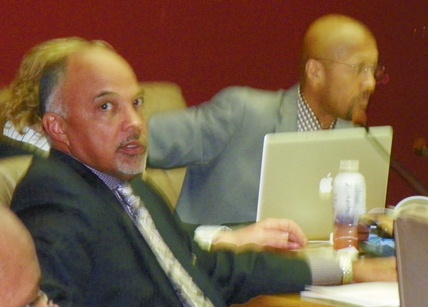
Detroit COO Gary Brown, shown in previous role on City Council with Council President and accused child molester Charles Pugh.
Detroit Chief Operating Officer and former City Council member Gary Brown, who voted for the consent agreement which eventually put Orr in place, said in published remarks that the parking fines will bring in an additional $6 million per year and $60 million over the 10-year plan of adjustment Orr is proposing under bankruptcy.
“That’s real money,” Brown said. “If the asset is truly an asset and making money, no one is going to want to do anything with it.” Orr has threatened to privatize the entire Department.
During his tenure on Council and his years in the Detroit Police Department, Brown rode in city-owned cars that could be parked anywhere without getting a ticket, as do Orr and his staff, which are being paid hundreds of millions in tax dollars.
From VOD’s direct observation across the city, most new parking machines which service a series of meters are broken, while many regular meters are also inoperable.
While covering the April 1 protest against Detroit bankruptcy cuts, this reporter received an illegal parking ticket for parking on Michigan Avenue where there was no sign indicating a no-parking zone. The meter attendant said a No Standing sign BEHIND her car applied to all cars in front of the sign, an issue which this reporter already challenged in court, and won.
 How many more of these illegal tickets are being handed out so meter attendants can meet their quotas? How many people can’t afford to take a day off work to show up for the hearings?
How many more of these illegal tickets are being handed out so meter attendants can meet their quotas? How many people can’t afford to take a day off work to show up for the hearings?
MAY 1 IS SHUT DOWN DETROIT DAY! CITY WORKERS—DON’T TICKET CARS, DON’T SHUT PEOPLE’S WATER OFF! AUTO WORKERS, OTHERS, DON’T GO TO WORK PERIOD; NO SHOPPING, NO CASINO PATRONAGE!
IF WE DON’T STAND UP NOW, WE WILL HAVE NO PENSIONS, NO JOBS, NO CARS, NO HOMES, NO SCHOOLS, NO YOUTH TO ATTEND THEM BECAUSE MOST WILL BE LOCKED UP, AND NO CHILDREN BECAUSE CPS WILL HAVE TAKEN THEM TO PROFIT THE STATE, FOSTER CARE AGENCIES AND THE PHARMACEUTICAL COMPANIES.
PACK THE HEARING APRIL 14 AT 3 PM IN THE ERMA HENDERSON AUDITORIUM AT THE COLEMAN A. YOUNG CENTER. ENOUGH IS ENOUGH!
Posted in Uncategorized
1 Comment
THOUSANDS OF RETIREES, RESIDENTS MARCH AT DETROIT BANKRUPTCY COURT, SEND OUT CALL TO SHUT CITY DOWN MAY 1
Largest protest yet includes numerous unions, community groups
Retiree creditors add hundreds more objections to Plan of Adjustment, call for NO vote
Amended POA threatens further attacks, up to 60 percent cuts in pensions, annuities, health care; plans to remove Retirement Board trustees
April 1, 2014
DETROIT –During a massive march April 1 outside the city’s federal courthouse, the site of bankruptcy hearings, Detroit residents, retirees, and union and community leaders announced plans to shut the city down May 1. The protest against Detroit Emergency Manager Kevyn Orr’s bankruptcy filing was the largest yet.
“No pension, No peace,” protesters chanted. “Let me hear you scream, May 1, Shut it Down!”
A yellow flier distributed at the rally, with multiple endorsers, asked Detroiters, “Do not shop, go to work, buy lottery tickets, alcohol or anything.” The flier condemns the undemocratic “emergency management” of Detroit and other majority-Black cities across Michigan, which paved the way for the Detroit bankruptcy filing. It says the action will start at United Auto Workers Local 600 headquarters at 10550 Dix Ave. in Dearborn, Michigan at 8 a.m. May 1.
“Two weeks ago Detroit Emergency Manager Kevyn Orr told the media he felt the Plan of Adjustment, meant to cut our throats, would go through very easily because there is ‘very little social unrest,’” said Dave Sole, of the Stop the Theft of Our Pensions Committee. “But here today we have many veterans of the civil rights movement, union veterans, people who helped stop the Vietnam War. There are enough of us retirees, workers and residents who can shut down the City-County Building, shut the court down, block all the streets, go over to GM’s Renaissance Center, to Chase Bank and others, and shut the m-f’s down.”
Speakers said they were enraged by Orr’s amended Plan of Adjustment and Disclosure Statement filed May 31. It ramps up attacks on pensions, threatening further cuts if retirees do not vote for the plan, and sets out a plan to get rid of current retirement board trustees so Orr and the state can raid the pension plans without opposition from the duly elected trustees.
“It’s talking about at least a 60 percent cut in retiree benefits, and now they’re going after our annuities,” said Mike Mulholland, Vice-President of the Detroit Water and Sewerage Department’s AFSCME Local 207.

- Mike Mulholland and Susan Ryan of DWSD AFSCME Local 207. Mulholland noted the danger to labor unity posed by the breaking up of their local into three sections, dominated by the IUOE and the Teamsters. Local 207 led a strike in 2012 that should have spread through the city, but was sabotaged by top union leaders, who are now seeing the results of their betrayal in the attempted destruction of Detroit.
“It’s not about fixing Detroit’s streetlights, but about taking over Belle Isle, the Public Lighting Department, the Water Department, City Airport. The fix has been in from the beginning. Millions and millions of dollars are being spent on bankruptcy consultants, while they are not doing one thing to rebuild Detroit. Who can survive these cuts? We might as well move to the cemetery, open up a coffin and lay down. But we must stand deep and fight!”
Tina Person, also known as the “East Side Lady,” said “We need Django in the City of Detroit,” referring to the popular movie “Django Unchained.” Starring Samuel Jackson and Jamie Foxx, it depicts a former slave joining forces with a bounty hunter to track down outlaw slave traders.
“They are giving everything away that belongs to the people of Detroit,” Person said. “We must take our city back. The City Council, which just gave away Joe Louis Arena, should be run out of town on a rail.” (Video below by Morris Mays.)
Rev. Charles Williams Sr. of the National Action Network said, “We are here to tell our young people this is where we came from. If you want justice, stand up and fight back! On May 1, shut this city down! Get out in the community, talk to everyone on the phone, get involved! This is not a game. Save the children, save the babies, save humanity from the corporations, from the Koch Brothers, who are trying to take over cities all across America. Let the world know, let the whole country come—on May 1, shut it down!”
Orr’s POA and Disclosure Statement particularly target retiree annuities, also administered by the city’s Retirement Systems. Annuities are savings plans supplement pensions, are were built up by city workers’ contributions over the years and invested by the retirement systems to earn more money. As do many private plans which offer even higher fixed rates of return, city annuities have paid a guaranteed annual rate of return of case 7.9 percent, despite market rate fluctuations.
Ben Bernanke, chairman of the Federal Reserve, has much of his wealth tied up in two private annuities, one with a fixed rate of return and one variable.
But Orr claims the use of fixed rates was irresponsible, and that annuities should be tied only to “market rates” of return. He wants thereby to recoup large portions of workers’ annuities paid out from 2003-2013, adding to the 34 percent he also wants to cut from workers’ pensions. To do so, he proposes to remove the current trustees of the city’s retirement systems and replace them with appointed “experts.”
Below is a chart from http://financeandinvestments.blogspot.com, part of a series of charts showing rates beginning with the year 1926. The charts show that the average S&P 500 annual rates of return for private annuities from 1926 through 2011 were 9.77 percent. Over the last 20 years, the S&P 500 averaged 7.81 percent. (See What rate of return should you expect to earn on your investments.)
The Detroit General Retirement System’s guaranteed rates of return for annuities have been 7.9%, very closely approximating the S&P 500 market rate.
S&P 500 RATES OF RETURN 1992-2011 AVERAGED 7.81%
Additionally, the Lehman Aggregate Bond Index was used by the retirement systems as well as 90 percent of businesses for years before the company’s catastrophic collapse in 2008, which set off a global economic meltdown stemming from Wall Street’s unbridled predatory lending practices. Any fluctuations in Detroit General Retirement System rates of return should be investigated for their connection to this index.
Ernst & Young, Lehman Brothers’ bookkeepers, are one of several City of Detroit consultants on the bankruptcy plan, being paid millions by Detroit taxpayers. They are being sued by the states of New York and New Jersey for losses they suffered due to investments recommended by Lehman Brothers.
In the same fashion, UBS AG and Bank of America, which hold billions of Detroit’s debt, and numerous other members of the London Interbank Offered Rate (LIBOR) board, fraudently manipulated interest rates world-wide so the banks could profit. They are facing criminal and civil charges across the world, including a $1.5 billion penalty paid to the U.S. Department of Justice.
But Orr’s Plan does not demand that UBS AG or BOA return one penny of the original, predatory and fraudulent $1.5 billion Pension Obligation Certificate loan they foisted on the City of Detroit beginning in 2005. Standard and Poor’s and Fitch Ratings recommended the loans, and Detroit CFO Sean Werdlow took a top position with minority lender Siebert, Brandford and Shank, backed by Bank of America/Merrill Lynch, five months later. He is currently the company’s COO.
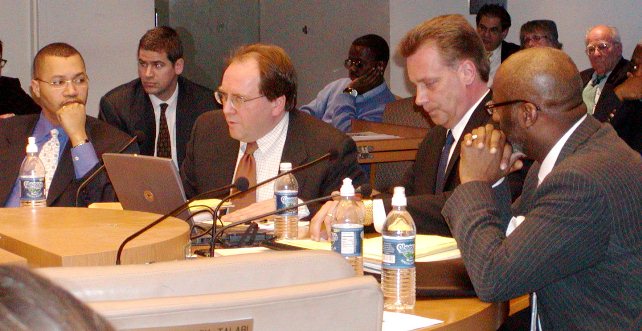
(L to r) Detroit CFO Sean Werdlow, Joe O’Keefe of Fitch Ratings, Stephen Murphy of Standard and Poor’s, and former Deputy Mayor Anthony Adams sell predatory, disastrous POC deal to City Council Jan. 31, 2005.
Although the City of Detroit filed suit against the phony Retirement System Corporations set up to handle the POC’s, Bankruptcy Judge Steven Orr has never heard the suit. Instead, the day after the demonstration, he approved an $80 million payment to UBS AG and BOA to settle their claims on lesser interest swap agreements related to the POC’s. That approval cuts off the City’s ability to recoup the entire POC debt.
After the rally at the courthouse, protesters marched to the offices of the U.S. Bankruptcy Court at 211 W. Fort St., where hundreds lined up to file more objections to Orr’s Plan of Adjustment and Statement of Disclosure. March organizers encouraged people to continue filing, saying the deadline is now April 28, 2013.
More analysis from VOD on the bankruptcy case will be forthcoming.
Download flier at May 1 Shut Down Detroit flier.
Download Orr’s revised Plan of Adjustment, filed March 31, 2014, at DB amended POA 3 31 14 and revised Disclosure Statement by going to http://www.mieb.uscourts.gov/sites/default/files/detroit/docket3382.pdf.
Posted in Uncategorized
1 Comment
U.S. HANDS OFF VENEZUELA!
Washington Threatens Sanctions
Coup “Option” Looms Larger
Obama: Recognize the Democratically Elected Government of Nicolás Maduro!
Statement by Socialist Organizer
March 30, 2014
Washington is up to its dirty tricks again in Venezuela.
It began February 18, 2014, in Toluca, Mexico, at a Trinational North American Leaders Summit focused on promoting the Trans-Pacific Partnership Agreement (TPP), a “free trade” pact that would seriously hurt working people in all countries concerned. At that gathering, President Obama stated cynically that, “instead of trying to distract attention from their own failures by making false accusations against U.S. diplomats, the Venezuelan government should focus on addressing the legitimate grievances of its own people.”
Obama’s statement followed the expulsion of three U.S. embassy officials from Caracas and was immediately understood across the continent for what it was — support for “regime change” in Venezuela. Obama’s formulations were almost identical to ones used by the central leaders of the opposition in Venezuela who had decided — with U.S. funding and political backing — to take to the streets and commit acts of violence and vandalism aimed at destabilizing the government of President Nicolás Maduro.
U.S. government funding for the opposition in Venezuela is, in fact, public knowledge. According to Mark Weisbrot (The Guardian, February 18), “There’s been $90 million in the U.S. federal budget since 2000 for funding opposition activities inside Venezuela, with $5 million alone in the 2014 budget. And this is almost certainly the tip of the iceberg, adding to the hundreds of millions of dollars of covert support over the past 15 years.”
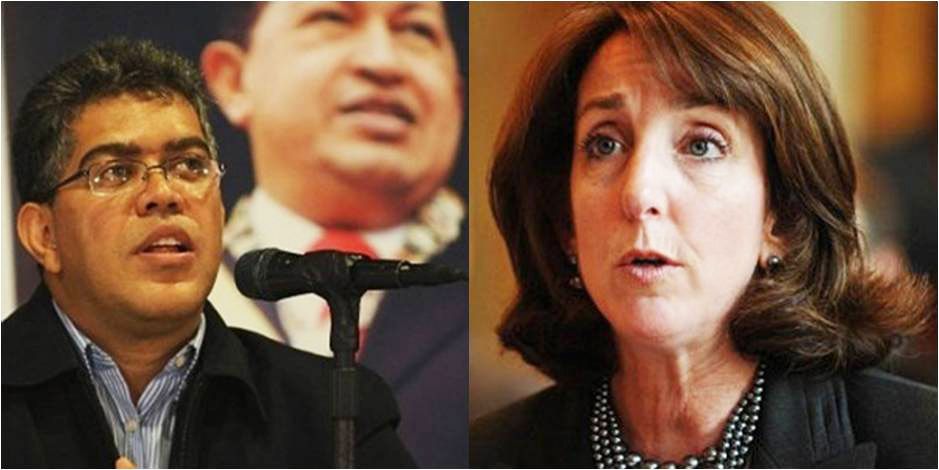
Venezuela’s Foreign minister Elías Jaua and US Assistant Secretary Roberta Jacobson: “If the United States resorts to economic sanctions or otherwise, we will counter with trade, energy, economic and political measures as we deem necessary to respond forcefully to this unacceptable threat; we do not accept any empire threats” said Jaua during an interview with Venezuelan government TV Channel Telesur in Ecuador, where he attended a meeting of the Bolivarian Alliance for the Peoples of Our America (ALBA).
Washington’s railings against Venezuela became much harsher one month later. On March 27, speaking at a press conference for the Latin American media, U.S. Assistant Secretary of State for the Bureau of Western Hemisphere Affairs Roberta Jacobson made the most threatening declaration to date by a top administration official, stating that as far as Washington is concerned “all options are on the table if the Venezuelan government fails to make democratic room for the opposition.”Jacobson stated that the Obama administration is strongly considering imposing sanctions against Venezuela “if there is no dialogue in Venezuela, if there is no democratic room for the opposition.” (El Universal, Mexico, March 28)
This argument is totally bogus; it is but a thinly veiled cover for stepped-up intervention in the internal affairs of the Venezuelan people, a further violation of their right to self-determination.
On February 16, the Mercosur governments (Brazil, Argentina, Uruguay, Paraguay, and Venezuela) released a statement on “the recent violent acts” in Venezuela and derided the “attempts [by the opposition] to destabilize the democratic order.” The governments stated “their firm commitment to the full observance of democratic institutions and, in this context, reject[ed] the criminal actions of violent groups that want to spread intolerance and hatred in the Bolivarian Republic of Venezuela as a political tool.”
On February 28, President Maduro convened a National Peace Conference in an attempt to defuse the highly charged political situation, but the gathering was boycotted by the U.S.-funded Democratic Unity Roundtable (MUD). These forces have acknowledged publicly that they are incapable of winning elections in the framework of the Venezuelan Constitution, so they must resort to other, extra-legal means — that is, provoking chaos through street violence and blockades (in which 36 people have already been killed) — to achieve their objectives.
Even the Organization of American States (OAS), which is dominated by the United States and has traditionally backed all U.S.-funded coup d’etats and assassination attempts of foreign leaders, rejected a proposal on March 7 by the U.S. representative to assemble a “Commission of Inquiry” to investigate the “failure by the [Maduro] government to create a democratic space for the opposition in Venezuela.” The United States had only two supporters for its motion: Canada and Panama.
And on March 24 a Commission of UNASUR (Union of Nations of South America), in which the U.S. has no seat, arrived in Venezuela to facilitate a “dialogue” between the government and the opposition. The delegation met with the coalition of opposition parties.
Never mind that Washington is more and more isolated in the Americas over its policy in Venezuela. The Obama administration — which has never even officially recognized the April 2013 election of President Nicolás Maduro — is readying to charge ahead with sanctions, if not more.
On March 13, U.S. General John Kelly, the highest authority of the Southern Command of the U.S. Armed Forces testified before the War Affairs Committee of the Senate in Washington about the crisis in Venezuela.
Kelly gave a detailed account of how the Venezuelan army and police have reacted to the two-month violence provoked by the right-wing opposition. He then went on to suggest that “probably there are pressures, arguments and disagreements within the armed forces of Venezuela on the state of the country.”
Much of the Latin American press took note at the time of the fact that it was a general in the U.S. Marine Corps, not a civilian specialist or a diplomat, who was brought in to testify before the Senate committee. Many in the media went on to warn that this scenario was ominously reminiscent of the period leading up to the April 2002 (failed) coup — organized and financed by the U.S. government — against then-President Hugo Chávez.

- Commemoration of anniversary of Pres. Hugo Chavez’ death March 5. Tens of thousands marched to support Chavez and his successor Maduro across the country.
And sure enough, on March 25 President Nicolás Maduro announced that three Venezuelan Air Force generals had been arrested on charges of plotting a military coup. Maduro stated that the generals had been the subjects of an investigation after junior Air Force officers who had been asked to join in the conspiracy alerted the government.
The Spanish daily El País, which openly supported the coup against Chávez on April 11, 2002, wrote the following in an editorial dated March 28: “The feeling of instability felt across the country is so great that no one can discard an action of this type [referring to a coup d’etat].”
Working people in the United States have no interest in backing Washington’s intervention and threats against the democratically elected government of Venezuela.
Workers in Venezuela have made important gains in the unfolding revolutionary process — gains that are unacceptable to the banksters in Wall Street and their hired hands in Washington. A recent Manifesto Against the Pro-Imperialist Coup Plot issued by two dozen unions in the Venezuelan region of Maracaibo summarizes these gains as follows: national health care and Social Security for all, decent guaranteed pensions for all, strict labor laws to protect workers, and, most important, State control/ownership over the nation’s resources such as petroleum, iron, aluminum, electricity, and more.This is what’s involved: It’s an attempt by the corporate elite in this country and their lackeys in Venezuela to turn back the clock and undo all the gains made by the workers and people of Venezuela through bitter struggles, which includes their valiant defeat of a previous U.S.-funded attempted coup against Hugo Chávez.
The Manifesto of the trade unions in Maracaibo underscores the fact that a central reason for the economic crisis in Venezuela’s — aside from the disruption and sabotage by sectors of the Venezuelan ruling class –is the country’s continued subordination to international finance capital. Because Venezuela is still paying back the foreign debt to the international bankers, there are few remaining dollars in the state coffers to import needed goods or to repay national companies.
The unions signing the Manifesto “call upon compañero Nicolás Maduro to go beyond the expulsion of U.S. ambassadors and functionaries involved in these provocations [and] break with imperialism by not repaying the foreign debt in order to address a platform of demands that express the nation’s defense. The income from the nation’s oil production belongs to the people, not the capitalists.”
This task, of course, is the task of the Venezuelan workers and people themselves.
For our part, the best help that we who live in the belly of the beast can offer the embattled workers and people of Venezuela is to stay the hand of our own imperialist government. This is why we here in the United States must raise our voices loud and clear — in whatever manner is most appropriate, including mass protests in the streets — to demand:
– U.S. Hands Off Venezuela!
– Obama: Recognize the Democratically Elected Government of Nicolás Maduro!
Related stories:
Posted in Uncategorized
Leave a comment
RALLY, FILE PEOPLE’S OBJECTIONS TO BANKERS’ ATTACK ON DETROIT TUES. APRIL 1, 10 A.M; HUNDREDS HAVE ALREADY FILED
File a People’s Objection to the Plan of Adjustment – April 1, 2014
Updated on March 25, 2014
All Out April 1 – File your objection in court
10 AM
Federal Courthouse, 231 W. Lafayette St., Detroit
File your objection to the “Plan for the Adjustment of Debts of the City of Detroit” and/or “Disclosure Statement With Respect to Plan for the Adjustment of Debts of the City of Detroit”.
The deadline for filing objections to the Disclosure Statement April 1, 2014.
The deadline for filing objections to the Plan of Adjustment is April 28, 2014.
 Join the people of Detroit in a mass filing of people’s objections to the Plan of Adjustment and and the Disclosure Statement at the during the Demonstration at the Federal Courthouse in downtown Detroit at 10 am. Most people will only file objections to the Plan of Adjustment. (more)
Join the people of Detroit in a mass filing of people’s objections to the Plan of Adjustment and and the Disclosure Statement at the during the Demonstration at the Federal Courthouse in downtown Detroit at 10 am. Most people will only file objections to the Plan of Adjustment. (more)
Download instructions and forms here (updated on 3/25/2014):
People’s Objection Instructions
People’s Objection to the Plan of Adjustment form
People’s Objection to the Disclosure Statement form
read more: All Out April 1 – File your objection in court
http://detroitdebtmoratorium.org/
BIG MEDIA, JUDGE RHODES IGNORE OVER 200 OBJECTIONS ALREADY FILED BY RETIREES
By Diane Bukowski
March 27, 2013
DETROIT — Over 200 retirees and other Detroiters have already filed profound and moving individual objections to Detroit Emergency Manager Kevyn Orr’s austerity plan for Detroit retirees and residents in bankruptcy court.
Some are handwritten, some are typed letters and articles, some are statements by groups such as Detroiters Opposing Emergency Managment (D-REM). U.S. Bankruptcy Judge Steven Rhodes, however, has not seen fit to include these on the court’s free website, under its special Detroit subsection. Big media is reporting only on filings by the banks and organizations opposing them, including the retirement systems and unions.
VOD, however, has downloaded each individual objection from the official U.S. Federal Courts PACER website (which charges a fee), so that its readers can hear directly from individual retirees, ALSO FOR FREE. Rhodes is duty-bound to read these objections and consider them during the plan of adjustment hearings ahead.
Below are excerpts copied from these objections. (If hard to read, use “Tools” button on your toolbar to enlarge.) Below those, VOD is posting a link to each individual objection.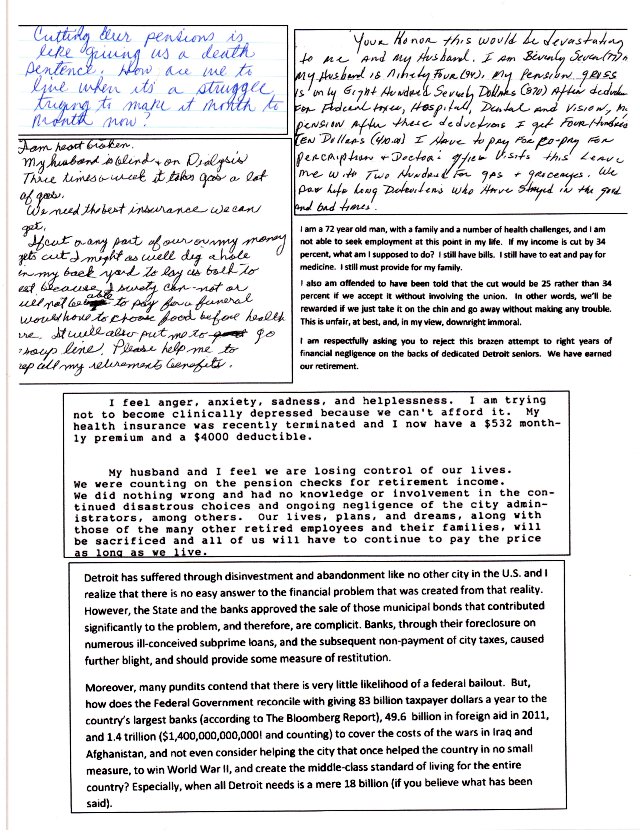
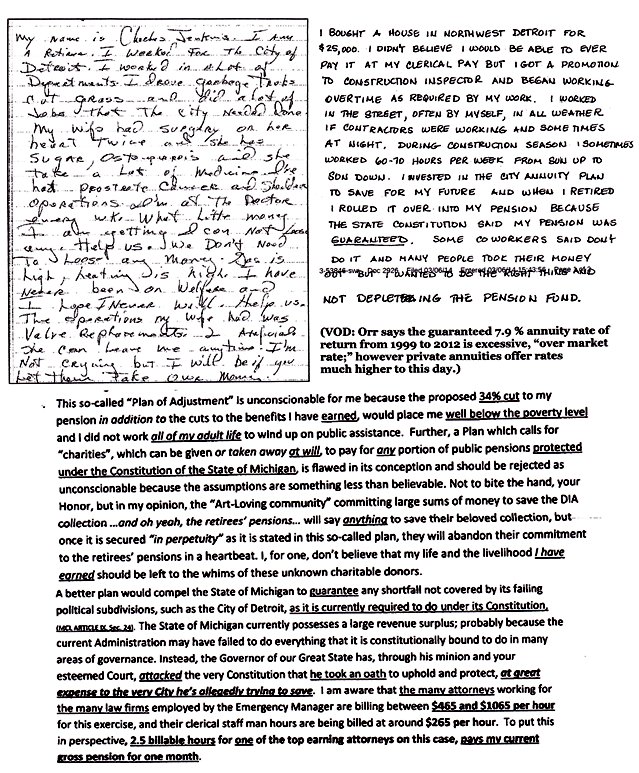
http://voiceofdetroit.net/2014/03/28/detroit-declares-war-on-pensioners-proposed-cuts-amount-to-70/
Links to over 200 individual retiree objections, not on free court website: Continue reading
Posted in Uncategorized
Leave a comment
DETROIT DECLARES WAR ON PENSIONERS; PROPOSED CUTS AMOUNT TO 70%

French workers have turned out in massive rallies all over the country to fight pension cuts by Hollande government.
By Workers World Detroit bureau
February 25, 2014
Emergency Manager Kevyn Orr’s “Plan of Adjustment” is a declaration of war on the city of Detroit’s 20,000 retirees and their pensions. The plan, filed Feb. 21 in the city’s bankruptcy case, calls for a 34 percent cut in monthly pension payments to non-uniformed retirees.
At a Feb. 22 meeting of the American Federation of State, County and Municipal Employees Retiree Committee, Ed McNeil, assistant to the president of AFSCME Council 25 and AFSCME representative to the “Official Committee of Retirees” created by the bankruptcy trustee, stated that the actual cut in total pension benefits amounts to 70 percent for each city retiree.
Yearly cost-of-living adjustments of 2 percent are to be eliminated. Annuity savings plans, under which pensioners were guaranteed 7.9 percent yearly interest payments on optional contributions to the pension fund, will also be drastically reduced based on alleged overpayments by the Pension Board from 1999 to 2013. The pension cuts are to be applied retroactively to the bankruptcy filing date of June 2013.
In addition to cuts in monthly cash payments, which are deferred wages earned by and belonging to city workers, retirees have already had their medical benefits drastically slashed. Life insurance and death benefits are being eliminated. Dental and vision coverage have ended.
Retired Detroit police and firefighters, who don’t get Social Security benefits, are to have their monthly pension checks cut by 10 percent, in addition to the aforesaid annuity reductions and benefit cuts.
Current city employees will have their accrued pension benefits frozen as of July 1. Their credit for pensions based on years worked will stop accumulating as of that date, with the accrued pensions subject to the same reduction as the current retirees.
Threat to public workers everywhere
 The same day EM Orr announced this full-blown attack on city of Detroit retirees, the federal Sixth Circuit Court of Appeals agreed to hear appeals filed by Detroit unions and retirees against the entire bankruptcy filing. These appeals challenge the bankruptcy for violating the Michigan constitution, which states the accrued pensions of public workers cannot be diminished or impaired.
The same day EM Orr announced this full-blown attack on city of Detroit retirees, the federal Sixth Circuit Court of Appeals agreed to hear appeals filed by Detroit unions and retirees against the entire bankruptcy filing. These appeals challenge the bankruptcy for violating the Michigan constitution, which states the accrued pensions of public workers cannot be diminished or impaired.
Orr, the bankers and the capitalists he represents want the Detroit bankruptcy to set a precedent for slashing public pensions in the 24 other states that have similar constitutional protections for public workers.
Orr had the audacity to state that the pension cuts for non-uniformed retirees will be reduced from 34 percent to 26 percent, and police and firefighters from 10 percent to 4 percent, if the unions and retiree organizations drop their legal challenges.
 Under Orr’s plan, the city, which stopped contributing to the pension plans after the bankruptcy was filed, would not make any contributions until 2023. The reduced pensions are to be funded by a $365 million donation by charitable foundations; a $100 million contribution from the Detroit Institute of Arts, which would remain open under private management pursuant to this deal; and a $350 million contribution from the state of Michigan earmarked to provide some additional benefits to the poorest retirees, also contingent on the unions dropping their opposition. If any of these sources do not make the promised payments, pensions will be slashed even further.
Under Orr’s plan, the city, which stopped contributing to the pension plans after the bankruptcy was filed, would not make any contributions until 2023. The reduced pensions are to be funded by a $365 million donation by charitable foundations; a $100 million contribution from the Detroit Institute of Arts, which would remain open under private management pursuant to this deal; and a $350 million contribution from the state of Michigan earmarked to provide some additional benefits to the poorest retirees, also contingent on the unions dropping their opposition. If any of these sources do not make the promised payments, pensions will be slashed even further.
Media misrepresentations
Much of the corporate-owned media tried to portray Orr’s plan as a concession to retirees when compared with other so-called unsecured creditors, holding $537 million in bonds, who will get only 20 cents on the dollar. But pensions are hardly “unsecured credit.” They are deferred wages, owed to city workers for labor already performed, and future payments agreed to in exchange for wage reductions by the workers on numerous occasions in order to preserve city services.

- U.S. Pres. Barack Obama plays golf with Robert Wolf, chairman/CEO of UBS AG America, which is getting fully paid on water bonds.
In contrast, in Orr’s plan the city will pay 100 percent of the principal owed on the city’s $5.35 billion Detroit Water and Sewerage Department bonds. The DWSD took out bonds totaling approximately $1 billion in 2011 and 2012, allegedly to raise funds for infrastructure repair.
The local media have not reported that half of this $1 billion in bonds was turned over to JPMorgan Chase, United Bank of Switzerland, Morgan Stanley and Loop Financial as termination fees for an interest rate swap that defaulted based on Gov. Rick Snyder’s declaration of a state of financial emergency for Detroit. (Bloomberg News, Sept.13, 2012)
Other bonds totaling approximately $585 million and backed by state revenue-sharing dollars will also be paid 100 percent. And despite the fact that Orr has challenged the legality of the city’s $1.4 billion in pension obligation certificates, he is offering those holders to settle at 40 percent of value.
Bank foreclosures not even mentioned
Orr’s 440-page statement goes into great depth about the financial crisis which led to the disastrous situation facing Detroit’s neighborhoods. However, it avoids any mention of the banks and their role in causing that crisis or any demands on them for restitution for the destruction they caused.
Orr’s report documents that after Detroit suffered a two-thirds decline in property values from 1970 to 1990 (caused by Chrysler and General Motors’ massive plant closings, also omitted from the report), property values actually increased from 1990 to the mid-2000s as Detroit’s neighborhoods and population stabilized.
In the mid-2000s, however, Detroit, an 85 percent African-American city with a high rate of homeownership, was targeted by the banks with racist, predatory, fraudulent mortgage loans and refinancings. From 2004 to 2006, 73 percent of mortgages written in Detroit were subprime. Oppressed homeowners across the U.S. faced a similar nightmare.
The city’s Planning and Development Department reported in January 2009 that Detroit had the highest home foreclosure rate among U.S. cities, with 67,000 foreclosed properties from 2005 to 2009, 65 percent of which remained vacant. There were at least another 40,000 mortgage foreclosures from 2009 to 2013, on top of tens of thousands of property tax foreclosures. This foreclosure epidemic caused the destruction of Detroit’s neighborhoods and the loss of one-quarter of the city’s population.
The centerpiece of Orr’s program for “revitalizing” Detroit is a massive blight-removal program to demolish 80,000 vacant buildings in the city. But there is not one word about making the banks pay for the devastation they have wreaked. Instead, pensioners are to take deep cuts in their monthly income.
Fightback can reverse this attack
The questions now are whether the retirees will lead the way in taking to the streets in numbers necessary to reverse this anti-working class offensive, and whether the union leadership will mobilize its members nationally to come to Detroit, which is ground zero in the war on public unions and in the austerity imposed by finance capital on the world’s working class.
Emergency Manager Orr’s plan of adjustment has to be approved by U.S. Bankruptcy Judge Steven Rhodes before it is implemented. As in any working-class struggle, it is actions in the streets, not decisions in the court, which will be decisive. It is not too late to turn things around.
For more information, visit moratorium-mi.org and detroitdebtmortorium.org.
Detroit struggle ramps up versus emergency manager
Resistance ramps up against Detroit bankruptcy as role of banks is exposed
Detroit City Council tells EM and banks, ‘No!’
Posted in Uncategorized
Leave a comment
THE GREAT $6.2 B REVENUE SHARING HEIST–MICHIGAN MUNICIPAL LEAGUE REPORT
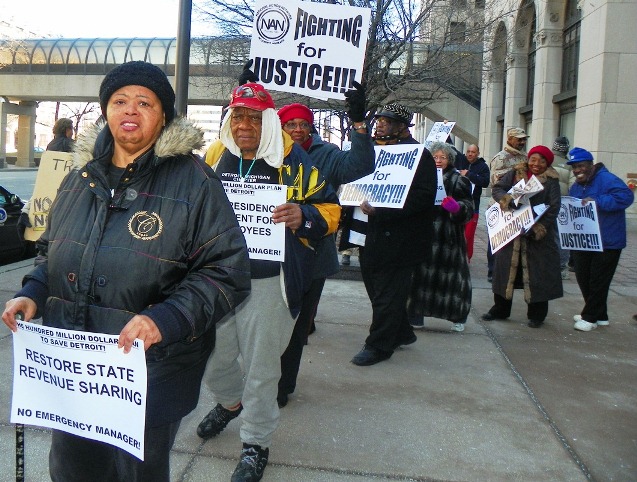
Protester Sandra Hines demands restoration of state revenue sharing to Detroit during protest at Cadillac Place State Bldg. March 4, 2013.
By Anthony Minghine
Associate Director of Michigan Municipal League
 An article posted from the Michigan Municipal League’s March/April 2014 Review Magazine
An article posted from the Michigan Municipal League’s March/April 2014 Review Magazine
There have been a lot of high profile robberies over the years. The Lufthansa robbery, D.B. Cooper highjacking, the Antwerp Diamond Caper…but these crimes look amateurish compared to the state of Michigan’s Great Revenue Sharing Heist. The state has managed to pinch over $6 billion in revenue sharing from local government over the last several years. Those numbers would even get Bernie Madoff’s attention.
Michigan’s broken municipal financing model is almost a cliché. Talking about budget numbers and deficits in the billions of dollars can cause us to lose perspective. The fact is, there are a record number of local governments that find themselves in the midst of a financial crisis. Is it the result of mismanagement, neglect, or incompetence? Or is it the result of a dramatic disinvestment by the state in local government? I suggest the latter.
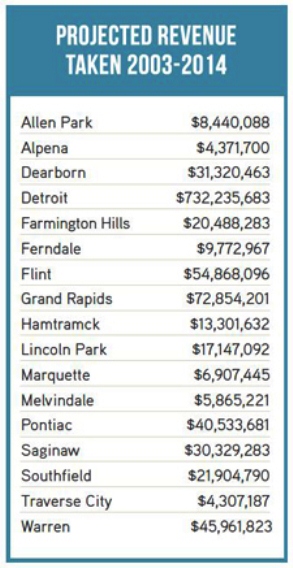 In my view, there are three major factors that have led communities to the financial brink: post retirement costs; a steep decline in property values; and a dramatic reduction in state revenue sharing. The third factor will be the focus of this article.
In my view, there are three major factors that have led communities to the financial brink: post retirement costs; a steep decline in property values; and a dramatic reduction in state revenue sharing. The third factor will be the focus of this article.
Post retirement costs are a huge issue that locals are grappling with. Change here is difficult at best; local governments are hamstrung with contracts and laws that make transformation slow. The property tax declines local governments have experienced could not have been anticipated to the degree they occurred, and are certainly out of the control of anyone in this state. Statutory revenue sharing, on the other hand, has been unilaterally taken by the state to solve its budget issues. It’s a fact. Revenue sharing is paid from sales tax revenues, which have been a remarkably stable source of income, and have in recent years experienced significant growth.
Breaking Down the Numbers
Hopefully you’ll stick with me, as I’m about to drop the “b” word. From 2003-2013, sales tax revenues went from $6.6 billion to $7.72 billion. Over that same period, statutory revenue sharing declined from over $900 million annually to around $250 million. The state is now in an enviable position—revenues that exceeded expectations. It is posting large surpluses but has failed to take steps to restore local funding.
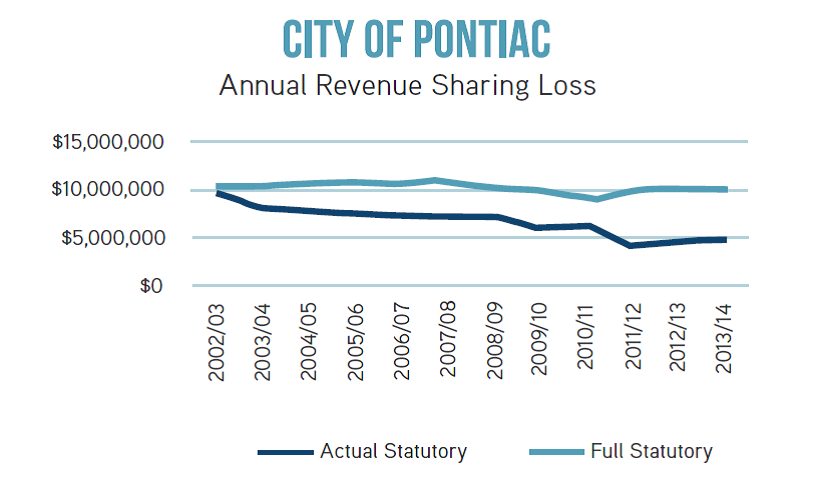 In fact, the state is trumpeting its sound fiscal management and admonishing local governments for not being as efficient. What the state fails to mention is that it balanced its own budget on the backs of local communities. This would be like me taking your money to pay my bills, and then telling you that you need to be more responsible with your house-hold budget. In fairness, the state did experience revenue declines out of its control, much like locals experienced with property tax declines. It is different, though, in one important way—local communities couldn’t take money from others and push those tough decisions down to someone else.
In fact, the state is trumpeting its sound fiscal management and admonishing local governments for not being as efficient. What the state fails to mention is that it balanced its own budget on the backs of local communities. This would be like me taking your money to pay my bills, and then telling you that you need to be more responsible with your house-hold budget. In fairness, the state did experience revenue declines out of its control, much like locals experienced with property tax declines. It is different, though, in one important way—local communities couldn’t take money from others and push those tough decisions down to someone else.
What is most shocking is the difference those revenue sharing dollars would have made at the local level. As I stated at the onset of this article, we now have a record number of communities facing financial emergencies. It’s easy to blame local leaders, but you must consider all the facts. In most cases, communities that currently face large deficits would in contrast have general fund surpluses.
Let’s Get Specific: Four Cities’ Cuts
 So what does it mean to specific com-munities? For Allen Park, an $857,000 deficit in 2012 becomes a surplus of over $5 million and would grow to a projected surplus of $7.3 million by 2014. Hamtramck’s deficit of $580,000 would have been a surplus of $8.7 million. Flint will have lost $54.9 million dollars by the end of 2014. The deficit in its 2012 financial statements is $19.2 million. Flint could eliminate the deficit and pay off all $30 million of bonded indebtedness and still have over $5 million in surplus. In Detroit, a city facing the largest municipal bankruptcy in history, the state took over $700 million to balance the state’s books.
So what does it mean to specific com-munities? For Allen Park, an $857,000 deficit in 2012 becomes a surplus of over $5 million and would grow to a projected surplus of $7.3 million by 2014. Hamtramck’s deficit of $580,000 would have been a surplus of $8.7 million. Flint will have lost $54.9 million dollars by the end of 2014. The deficit in its 2012 financial statements is $19.2 million. Flint could eliminate the deficit and pay off all $30 million of bonded indebtedness and still have over $5 million in surplus. In Detroit, a city facing the largest municipal bankruptcy in history, the state took over $700 million to balance the state’s books.
This data begs the question: did municipalities ignore their duty to manage or did someone else change the rules of the game and then throw a penalty flag at them? I see yellow flags all over the playing field. Post-retirement benefits are a huge expense and burden to local government, but we must not ignore the reality—the promises were made with a different expectation from the state as it relates to sharing sales tax revenue with local government. It’s a fact that the state has broken that promise. State leaders excused themselves from making tough choices, instead using local money to pay their bills. In the process, they have created most, if not all, of the financial emergencies at the local level.
 The numbers don’t lie. Revenue sharing is the only factor that anyone has had direct control over during these difficult financial times. It is time for the state to shift gears and start investing in local government again. Hardships at the local level weren’t created by a lack of cooperation or collaboration. I would humbly submit that local governments invented the concept and the state is very late to the table. Local government officials have done, and will continue to do, their part to be prudent managers, but the goal cannot be to hang on and survive. Our goal must be to ensure that our cities are vibrant places that people will choose to live in, and that can only happen if the state fulfills its promise and responsibility to invest where the rubber meets the road, and that is at the local level.
The numbers don’t lie. Revenue sharing is the only factor that anyone has had direct control over during these difficult financial times. It is time for the state to shift gears and start investing in local government again. Hardships at the local level weren’t created by a lack of cooperation or collaboration. I would humbly submit that local governments invented the concept and the state is very late to the table. Local government officials have done, and will continue to do, their part to be prudent managers, but the goal cannot be to hang on and survive. Our goal must be to ensure that our cities are vibrant places that people will choose to live in, and that can only happen if the state fulfills its promise and responsibility to invest where the rubber meets the road, and that is at the local level.
Anthony Minghine is the associate director of the League. You may reach him at 734-669-6360 or aminghine@mml.org. Download article at mml-revenue-sharing-heist-2014.
Michigan’s cities and villages are the centers of our economy. They maintain the infrastructure and services that support the vast majority of our state’s jobs. A recent study found that Michigan’s metropolitan areas account for 89% of the state’s jobs and 88% of its gross domestic product.1 The revenue sharing distribution formula was designed to appropriately compensate the communities that support us all and the higher costs they bear. Therefore, when that formula is underfunded, Michigan’s entire economy suffers. Revenue Sharing Keeps Our Economic Engines Running.

- Water from a leaking pipe covers the gymnasium floor at the Caroline Crosman School in Detroit Tuesday, Oct. 29, 2013. How much treated water is lost this way in Detroit is anybody’s guess. Not even the city knows. But the cost is passed on in higher rates to water customers who now face a renewed threat of shut-offs on delinquent bills. The department has announced it will lay off 700 more workers, who are sorely needed to deal with the city’s aging water infrastructure. (AP Photo/Paul Sancya)
A Michigan Municipal League survey found cuts in revenue sharing have negatively impacted basic community services across Michigan. Capital projects such as street and sidewalk repairs and sewer and water improvements have been postponed; recreation and library programs have been curtailed or eliminated. Perhaps even more startling is that, according to the Michigan Commission on Law Enforcement Standards, there are nearly 2,315 fewer police officers and 1,800 fewer firefighters on the streets of Michigan since the tragedy of September 11, 2001.2
Formula Funding
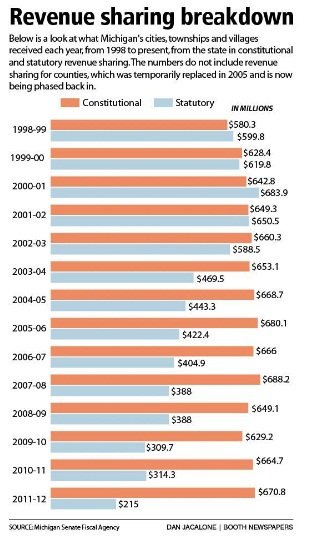 Revenue sharing consists of both constitutional and statutory payments. The constitutional portion consists of 15% of gross collections from the 4% sales tax3 distributed to cities, villages, and townships based on their population. This amount is set by the state constitution. The Legislature must appropriate whatever is calculated. It cannot reduce or increase the constitutional portion.
Revenue sharing consists of both constitutional and statutory payments. The constitutional portion consists of 15% of gross collections from the 4% sales tax3 distributed to cities, villages, and townships based on their population. This amount is set by the state constitution. The Legislature must appropriate whatever is calculated. It cannot reduce or increase the constitutional portion.
The statutory portion of revenue sharing has traditionally been distributed by a formula, rather than on a per capita basis, to compensate for the significant variation in local governments’ service delivery needs, infrastructure maintenance requirements, and fiscal capacity to generate local tax revenue. Today, the program calls for 21.3% of the 4% sales tax collections to be distributed in accordance with a formula set in Public Act 532 of 1998.
 Since state law sets the statutory portion, the governor and Legislature have the ability to adjust the distributed amount. They have increasingly used this ability to cover state budget shortfalls to the detriment of communities, especially during the recent recession when local budgets are already strained by drops in property value. The 1998 formula was designed to be phased in, but due to funding cuts it has never been fully implemented. If fully funded, statutory revenue sharing payments to local governments, including counties, in fiscal year 2014 would have totaled approximately $1.8 billion. Instead, the state kept $689 million, appropriating $1.1 billion to communities. This shortfall is part of a trend totaling nearly $6.2 billion in revenue sharing reductions during the last twelve fiscal years.4
Since state law sets the statutory portion, the governor and Legislature have the ability to adjust the distributed amount. They have increasingly used this ability to cover state budget shortfalls to the detriment of communities, especially during the recent recession when local budgets are already strained by drops in property value. The 1998 formula was designed to be phased in, but due to funding cuts it has never been fully implemented. If fully funded, statutory revenue sharing payments to local governments, including counties, in fiscal year 2014 would have totaled approximately $1.8 billion. Instead, the state kept $689 million, appropriating $1.1 billion to communities. This shortfall is part of a trend totaling nearly $6.2 billion in revenue sharing reductions during the last twelve fiscal years.4
In 2011, the State added requirements for local governments to obtain their statutory revenue sharing payments. Entitled the Economic Vitality Incentive Program (EVIP), locals must now comply with three categories to receive payments. The categories include accountability and transparency, consolidation of services, and unfunded accrued liability plan.
History of Shared Revenue
Michigan cities, villages, and townships receive revenue earmarked by the state constitution and statute to help pay for core governmental services such as police protection, fire service, roads, water and sewer service, and garbage collection. Known as “revenue sharing,” these funds have been tied to restrictions on local taxes. In 1939, an early instance of revenue sharing occurred when a state law removed intangible property from the local property tax base. A state intangibles tax was created and a method put in place to return funds to locals to help with lost revenues. Since that time, additional state taxes such as the sales, income and single business tax have been enacted, while the levy of local taxes has been pre-empted or eliminated. This has been done with a pledge from state officials that a portion of revenues raised from state taxes would be returned to locals—shared—for the provision of essential services.
1Source: RW Ventures, “Michigan’s Metropolitan Areas Fact Sheet”
2Source: Michigan Commission on Law Enforcement Standards and Michigan Professional Firefighters Union
3The additional 2% sales tax created in 1994 is earmarked specifically for schools.
4Source: House Fiscal Agency
Download this fact sheet at 2014-revenue-sharing-factsheet.

Protesters in Birmingham, Ala. denounce increase in sewage rates that was part of Mongtomery County’s exit from bankruptcy. JPMorgan Chase, guilty of massive bond fraud, was also forced to cut its debt payments from the County by 75 percent.
Posted in Uncategorized
Leave a comment





